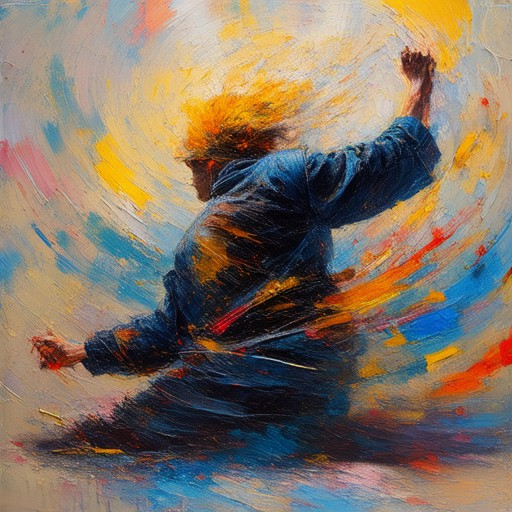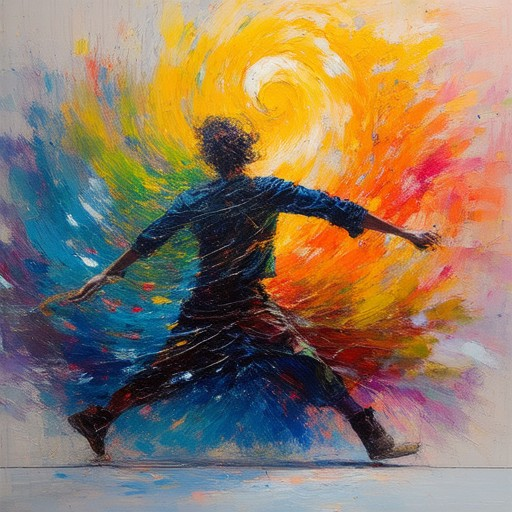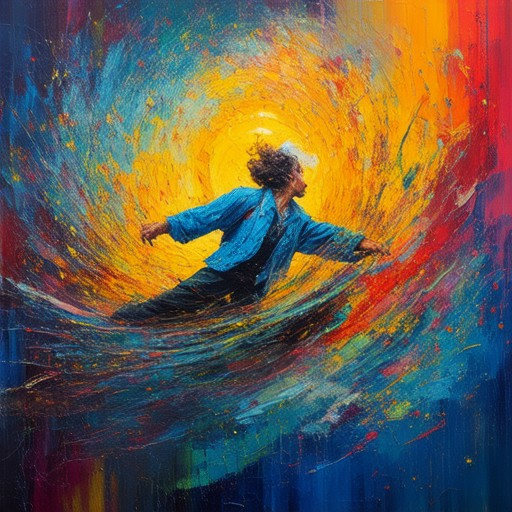Exploring the intricate dance between creativity and execution, the art journey and process offers a profound insight into the world of visual expression. This comprehensive exploration delves into the multifaceted nature of artistic creation, examining how artists navigate from initial ideas to completed masterpieces. Each stroke, each color, and every medium tells a story, reflecting the emotional, psychological, and technical complexities of the craft. Whether through the seven stages of art or the seven principles of composition, the journey is as much about the process as it is about the final work itself. From the emotional resonance of psychogeography to the dynamic influence of transport art, the art journey shapes not only the artwork but also the artist themselves. Understanding this process is to grasp the essence of art—where every step, no matter how uncertain, becomes a part of the masterpiece.

What Are the 7 Stages of Art?
The journey of art creation is a transformative process that can be broken down into distinct phases, each building upon the previous to foster growth and innovation. These stages are essential for any artist to develop their unique style and express their creativity effectively.
1. Emerging Artist
As an emerging artist , you are exploring the fundamentals of art, experimenting with various mediums, and discovering your personal style. This stage is characterized by curiosity, experimentation, and a willingness to take risks. It’s crucial to embrace feedback and refine your technique through constant practice and study.
Key Aspects:
-
- Exploration of different art forms
2. Developing Style
In this phase, you begin to solidify your artistic identity. Your work reflects a consistent theme, subject matter, and visual language. This stage requires deliberate practice, where you refine your skills and develop a recognizable style. It’s important to define your artistic vision and communicate it effectively through your creations.
Key Aspects:
-
- Clarity of artistic vision
3. Creative Exploration
This stage is marked by a freedom of expression and a willingness to push boundaries. Artists experiment with new ideas, concepts, and approaches, often leading to groundbreaking work. It’s a time for innovation and taking creative risks, which can result in unexpected and impactful art pieces.
Key Aspects:
-
- Freedom of expression
4. Masterpiece Creation
The creation of a masterpiece is a pivotal moment in an artist’s journey. This stage involves producing works that are technically flawless and emotionally resonant. It’s a time for focus, dedication, and channeling your artistic vision to create something extraordinary.
Key Aspects:
-
- Technical perfection
5. Artistic Evolution
As you progress, your artwork evolves, reflecting changes in your personal growth, cultural influences, and artistic explorations. This stage is about continuous learning, adaptation, and growth, ensuring your work remains fresh and meaningful.
Key Aspects:
-
- Continuous learning
6. Legacy Building
Once you’ve established your artistic legacy, your impact on the art world becomes undeniable. This stage involves leaving a lasting contribution to art history, inspiring future generations, and shaping cultural discourse.
Key Aspects:
-
- Leaving a lasting impact
7. Mastery
Mastery is achieved when you’ve perfected your craft and consistently produce exceptional work. This stage is about refinement, innovation, and leadership in the art world. It’s a recognition of your dedication and contribution to the field.
Key Aspects:
-
- Perfection of craft
What is the Concept of Journey in Art?
A journey in art refers to the exploration of creative expression through movement, space, and time. It encompasses both the physical act of creating art and the metaphysical experience of navigating an artistic process. Artists often use journeys as a way to uncover new perspectives, emotions, and ideas that inspire their work.
Examples of Journeys in Art
- Physical Journeys : Artists may use the physical act of moving across a canvas, floor, or three-dimensional space to create patterns, shapes, or narratives. This approach is often seen in works that reflect the artist’s personal movement or journey.
- Metaphorical Journeys : Journeys can also be conceptual, representing the artist’s emotional or spiritual exploration. For instance, a series of paintings might depict a character’s psychological journey through different stages of life or emotions.
- Creative Process : Many artists describe their creative process as a journey. This could involve experimenting with materials, techniques, or themes until a meaningful piece emerges. German artist Paul Klee famously said, “Taking a line for a walk.”
Resources for Art Enthusiasts
If you’re interested in exploring the concept of journeys in art, consider visiting Artful Journey . This platform provides valuable resources, tutorials, and insights for artists and art lovers. It covers various art forms, techniques, and inspiration to help you discover your own creative journey.
By embracing the concept of journey in art, you can unlock new dimensions of creativity and self-expression. Whether through physical movement, emotional exploration, or experimental techniques, the journey is a vital part of the artistic process.

Understanding Process in Art
The term “process” in art refers to the series of steps, techniques, and methods artists use to create their works. It encompasses both the technical aspects of art-making and the creative thinking that goes into it.
Technical Aspects
Process in art often involves a sequence of steps or actions that lead to the creation of a finished artwork. For example:
- Painting: Layers of paint application, blending, and drying times.
- Sculpture: Modeling, casting, and finishing materials to create three-dimensional forms.
- Digital Art: Using software tools for drawing, editing, and enhancing images.
Creative Thinking
Additionally, the creative process involves the mental and emotional journey artists take to generate ideas and evolve their style. This includes:
- Brainstorming concepts and themes.
- Experimenting with materials and techniques.
- Evolving personal styles and artistic expression over time.
Evolution Over Time
Artists often refine their process as they gain experience. This refinement can lead to changes in technique, subject matter, or stylistic choices. For instance:
- A painter may switch from oil paints to acrylics for faster drying times.
- A sculptor might explore new materials to create more dynamic textures.
Broad Application
Whether traditional or digital, the concept of process remains consistent across all art forms. It highlights the importance of understanding the steps involved in creating art, which can guide aspiring artists in developing their own approaches and styles.

Principles of Art
The principles of art are essential tools for creating visually appealing and meaningful artwork. These principles include balance, contrast, emphasis, movement, pattern, rhythm, and unity/variety. Understanding these principles helps artists communicate ideas effectively and create harmonious pieces.
- Balance: Achieved by distributing elements evenly, creating visual weight on both sides of the artwork.
- Contrast: Creates dramatic effects through high contrast (light/dark) or low contrast (harmony).
- Emphasis: Highlights important elements using color, shape, or size to draw attention.
- Movement: Conveys energy or direction using lines, shapes, and colors that guide the viewer’s eye.
- Pattern: Created by repeating shapes, colors, or textures to establish structure and texture.
- Rhythm: Similar to movement, rhythm is created by repeating elements to establish flow and pattern.
- Unity/Variety: Balances cohesion and diversity by combining elements to create a cohesive work while adding visual interest.
Learn more about art principles and techniques .
The Seven Elements of Art Explained
The seven elements of art are essential components that every artist uses to create visually appealing and meaningful artwork. Understanding these elements can greatly enhance your ability to express yourself through art. Here’s a breakdown of each:
- Line :
- A straight or curved path that creates edges and defines shapes.
- Example: The horizon in a landscape painting.
- We use lines to guide the eye and establish structure in our artwork. Explore different line techniques on Artful Journey .
- Shape :
- A two-dimensional area that is enclosed by lines.
- Example: A circle or square in a still life.
- Shapes can be organic or geometric, adding form and balance to your pieces. Discover more about shapes in art .
- Space :
- The area between objects or within a composition.
- Example: Negative space in a minimalist design.
- Space creates depth and makes artwork feel more dynamic. Learn how to use space in your art .
- Value :
- The lightness or darkness of colors in a scene.
- Example: Shading on a sphere to show three dimensions.
- Value helps create form and realism. Master value techniques on Artful Journey .
- Form :
- Three-dimensional objects or figures.
- Example: A stylized vase in a ceramic sculpture.
- Form adds depth and interest to your artwork. Explore form in art .
- Texture :
- Surface qualities that convey touch or sensation.
- Example: Rough brushstrokes in a portrait.
- Texture adds contrast and intrigue to your work. Discover texture tips on Artful Journey .
- Color :
- The elements that give objects their hue and appearance.
- Example: A vibrant palette in a abstract painting.
- Color evokes emotions and creates mood. Learn about color theory .
By mastering these elements, you can create art that is more expressive and impactful. Experiment with different combinations and see how they transform your creations. Remember, the key is to use these tools effectively to tell your unique story.

What Are the Fundamentals of Art in Order?
The fundamentals of art provide the foundation for creating meaningful and effective artwork. Here are the essential principles organized in order:
- Subject Matter : The core element of art revolves around the subject or theme you wish to convey. Whether it’s a portrait, landscape, or abstract concept, the subject matters.
- Technique : Mastery of tools, mediums, and styles is crucial. Whether you use oil paints, watercolors, or digital software, your technique defines your art’s quality.
- Composition : How you arrange elements within your artwork impacts its balance and visual appeal. Proper composition creates harmony and guides viewer focus.
- Color Theory : Understanding color interactions is vital. Color can evoke emotions, set moods, and harmonize your piece, enhancing overall impact.
- Form and Shape : Utilizing shape and form adds depth to your work. Whether organic or geometric, these elements contribute to visual interest.
- Purpose and Message : Art often serves a purpose, whether personal expression, cultural commentary, or historical documentation. Clarity of purpose enriches your work.
Additionally, consider these extras:
- Emphasis : Highlighting certain parts of your artwork draws attention and creates focal points.
- Contrast : Sharp contrasts between elements (light/dark, warm/cold) create visual interest and drama.
- Texture : Incorporating different textures adds depth and dimension to your pieces.
- Space and Depth : Manipulating space creates illusions and adds three-dimensional aspects to your work.
Mastering these fundamentals allows artists to communicate effectively and create art that resonates emotionally and visually. By focusing on these principles, you can develop a unique style and tell compelling stories through your artwork.




0 Comments